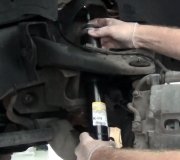Actually, I'm not sure of what happened. I'd have to look to see what type of suspension system your car has, but there's at least two designs where you tug, push, grunt, pry, and sweat to place the adjustment where you want it, then there are bolts to tighten that hold a bar from moving or squeeze the spindle inside a bracket on the strut. After many months, those bolts get rusty and do a pretty good job of holding the parts in place. Right after an alignment where those things needed to be adjusted, the bolts don't always grip like they should. Also, rust in the threads can make them feel like we have them sufficiently tightened but they aren't really tight enough to hold the parts where we want them. Hitting a big bump in the road can put enough force on the spindle to allow the adjustment to slip. That's when you'll get the pull and see the off-center steering wheel.
Sliding sideways into a curb can do this too. In fact, those slipping parts might absorb enough of the impact to prevent bending any suspension parts. You'll still need an alignment, but no parts.
In the '80s and '90s Chrysler used "cam" bolts to hold the camber adjustment in place. Those are bolts with over-size off-center heads that make the adjustment move as they're rotated. They help hold the adjustment from slipping. You could buy aftermarket bolts that did the same thing on GM cars. Ford used a different design on their front-wheel-drive cars that had no provisions for making a camber adjustment. They had a huge problem with real bad tire wear that couldn't be corrected. The rear-wheel-drive cars had a much better design.
It's important too to tell the mechanic if something like hitting a pothole happened. Many cars have enough camber adjustment to make up for slightly bent parts that aren't obvious without real close inspection. The problem is there are secondary alignment angles we don't normally check unless we think we need to, so while the three primary angles' numbers might look good on the alignment computer, those bent parts can still cause miserable and unpredictable handling, and poor tire wear. In some cases those secondary angles are pretty easy to correct before continuing with the rest of the alignment, as long as we catch it.
Sunday, February 7th, 2016 AT 2:45 PM


